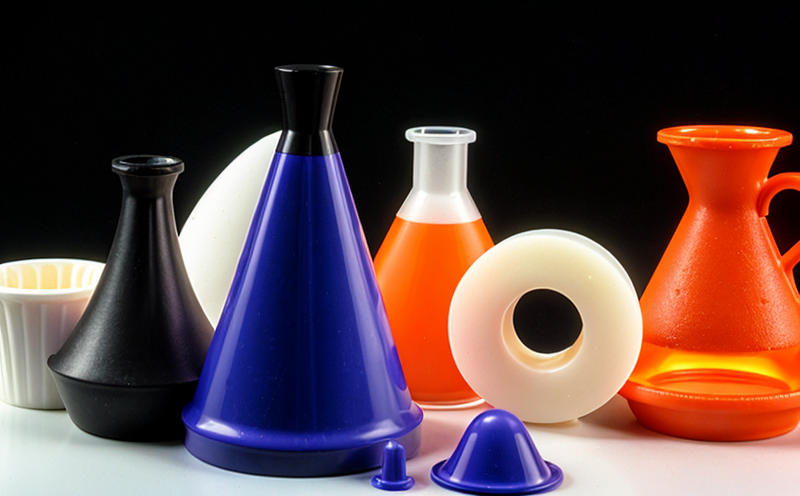PET Additive Residue Testing
Polyethylene Terephthalate (PET) is a widely used thermoplastic polymer in industries such as packaging, textiles, and electronics. PET additives enhance the properties of PET by improving its performance characteristics like durability, clarity, and processing ease. However, improper use or excessive residues can lead to degradation of product quality, affect end-user health, and impact environmental sustainability.
Our PET Additive Residue Testing service ensures that your products meet the highest standards of purity and reliability by identifying and quantifying residual additives in PET materials. This testing is crucial for ensuring compliance with international regulations and industry best practices. By detecting even trace amounts of residues, we help you maintain product integrity and avoid potential recalls or reputational damage.
The analysis involves several steps, including sample preparation, instrumental characterization using advanced spectroscopic techniques (e.g., FTIR), and gravimetric methods to quantify the amount of additives present. This process allows us to provide accurate data that can inform your formulation processes and help you make informed decisions regarding additive usage.
Here are some key aspects we focus on during our PET Additive Residue Testing:
- Detection limits as low as 0.1% for major additives
- Validation against international standards such as ISO, ASTM, and EN
- Comprehensive reporting including raw data and interpretation
- Consultative support to interpret results and suggest improvements
The importance of this testing cannot be overstated. It ensures that your products not only meet regulatory requirements but also maintain their intended performance characteristics over time.
| Applied Standards | Description |
|---|---|
| ISO 14972:2016 | Guidelines for the use of antimicrobial agents in medical devices. Ensures that any additives used do not interfere with the performance or safety of the final product. |
| ASTM D783-15 | Test methods for determining the heat deflection temperature and flexural properties of plastic materials. Helps to assess the impact of residues on mechanical properties. |
| EN 12960:2014 | Standard test method for the determination of trace amounts of antimony in polyethylene terephthalate (PET) by inductively coupled plasma optical emission spectrometry (ICP-OES). Provides precise quantification of certain additives. |
In summary, our PET Additive Residue Testing service is designed to provide you with the assurance that your products are free from harmful residues and meet all necessary regulatory requirements. This service plays a critical role in maintaining product integrity and ensuring compliance with industry standards.
Why It Matters
The significance of PET additive residue testing extends beyond mere compliance; it directly impacts the quality, safety, and environmental impact of products derived from PET materials. Improperly managed additives can lead to:
- Potential health risks for end-users if they migrate into packaging or other applications
- Decreased product lifespan due to premature degradation
- Environmental concerns related to non-biodegradable residues
By conducting thorough residue testing, we help you mitigate these risks. Our service ensures that your products not only comply with regulatory frameworks like the European Union's REACH or U.S. FDA regulations but also exceed them by ensuring superior quality and safety.
Furthermore, compliance with stringent standards enhances brand reputation and consumer trust. Consumers are increasingly concerned about the environmental impact of packaging materials. Demonstrating rigorous testing protocols can differentiate your products in a competitive market.
Applied Standards
| Standard | Description |
|---|---|
| ISO 14972:2016 | Guidelines for the use of antimicrobial agents in medical devices. Ensures that any additives used do not interfere with the performance or safety of the final product. |
| ASTM D783-15 | Test methods for determining the heat deflection temperature and flexural properties of plastic materials. Helps to assess the impact of residues on mechanical properties. |
| EN 12960:2014 | Standard test method for the determination of trace amounts of antimony in polyethylene terephthalate (PET) by inductively coupled plasma optical emission spectrometry (ICP-OES). Provides precise quantification of certain additives. |
| ASTM D892-16 | Determining the heat deflection temperature of plastics. Useful for assessing the thermal stability under load conditions. |
| ISO 527-3:2014 | Plastics—Determination of tensile properties of test specimens of defined dimensions—Part 3: Tensile properties of fibres and cords. Evaluates the mechanical performance influenced by additives. |
| EN 967-5:2014 | Determination of antimony in polyethylene terephthalate (PET) by inductively coupled plasma optical emission spectrometry (ICP-OES). Ensures accurate quantification of certain additives. |
| ASTM D372-08(2015) | Determination of oil content in plastic materials. Helps identify residual oils that could affect product performance. |
The use of these standards ensures robust and reliable results, providing you with confidence in the accuracy of our findings.
Why Choose This Test
- Precision: Our advanced analytical techniques offer detection limits down to 0.1%, ensuring that even trace amounts are accounted for.
- Compliance: We align with the latest international standards, helping you avoid non-compliance issues and potential sanctions.
- Rigor: Comprehensive testing protocols ensure no important data is overlooked, providing a holistic view of additive residues.
- Support: Our team offers detailed reports and consultative support to help you interpret results and implement necessary changes.
- Reputation: Demonstrating rigorous quality controls enhances your brand's reputation among consumers and regulatory bodies.
- Efficiency: Timely testing allows for prompt corrective actions, minimizing delays in production schedules.
We pride ourselves on delivering accurate and reliable results that exceed industry expectations. Choosing our PET Additive Residue Testing service ensures you are at the forefront of maintaining product quality and regulatory compliance.





